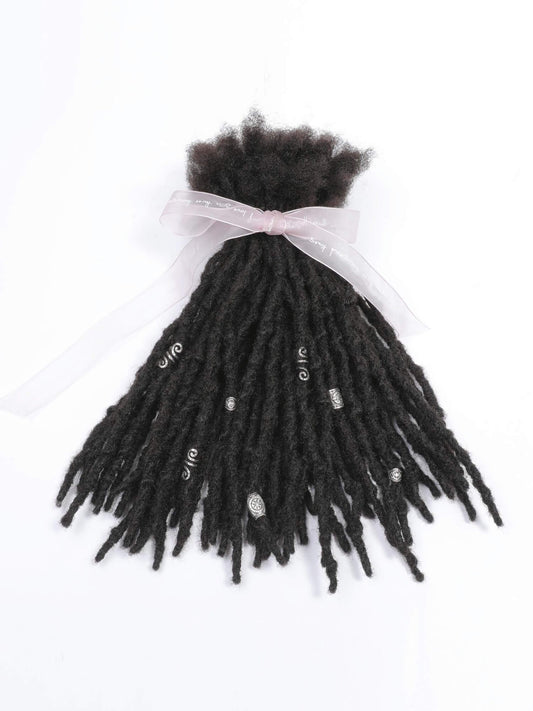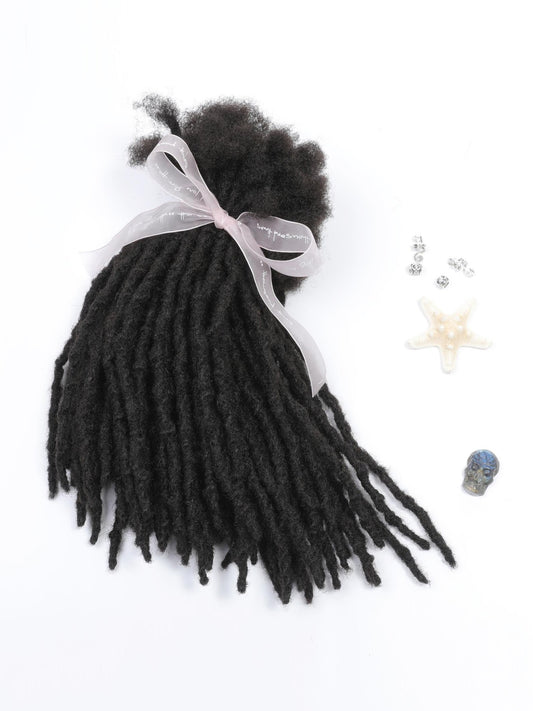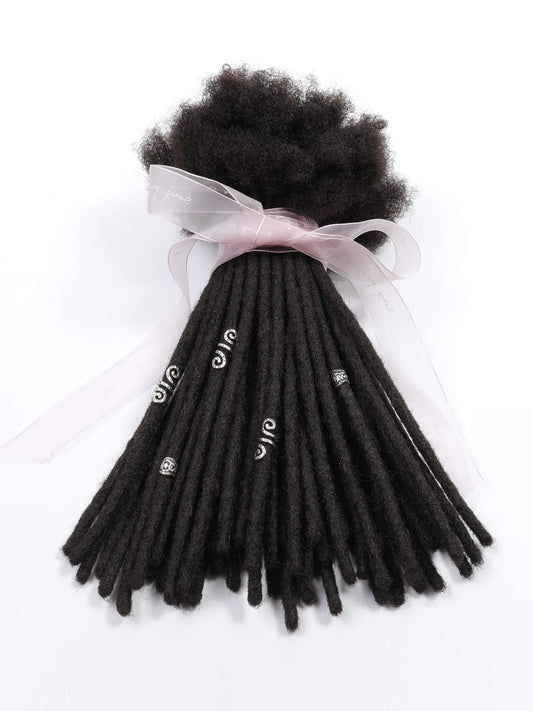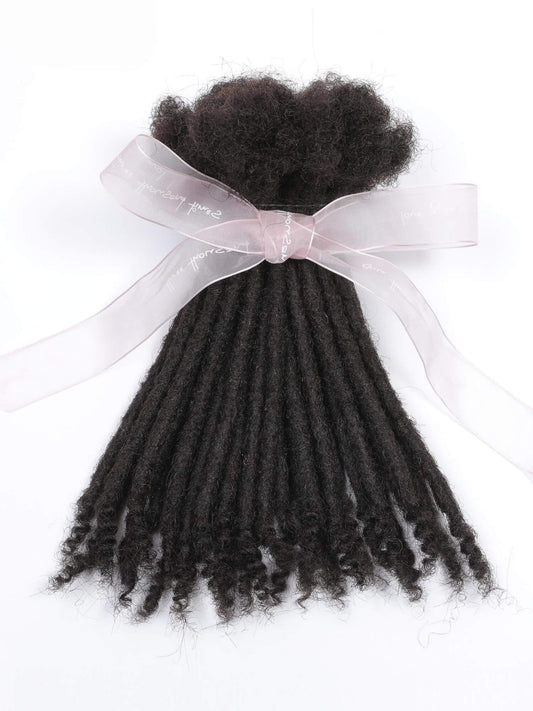If you are looking for a guide on hair loc, this is the right article. This article will guide you about freeform dreadlocks, how you can get the freeform locs, how to maintain freeform dreads, types of freeform dreads, and much more. Continue reading to get an idea of freeform locs and the pros and cons of the process.
What are Freeform Dreadlocks?

Freeform dreadlocks are a unique yet popular hairstyle among African men and women every day. Freeform dreadlocks are thicker dreadlocks as compared to traditional hair locs. In this hairstyle, the hairlines are not visible. Instead, the hair grows in twists or braids, beginning with the roots section. This hairstyle helps boost your natural hair with no manipulation.
It originated back in the era when Egyptians found mummies with dreaded hair. Since that era, dreadlocks have been getting popular with certain hair types. Nowadays, freeform dreadlocks afro is quite common, inspired by the Jamaican and Rastafarian culture. However, before starting this form of dreads, it is advised to look deeply into different hairstyles and different methods of getting the dreads.
Getting hair loss is a long commitment to your hair, so you must know that you will have to face different phases of the process. In certain phases, the hair gets frizzy, which sometimes gets irritating. Besides, the hairstyle is easy to carry with specific costumes without worrying about hairstyling options.
Moreover, growing any locs offers stunning results, but freeform dreads offer cultural significance. In addition, it also provides advantages on another level, such as on a spiritual level, and helps people boost their inner self with patience and commitment.
What are Semi-Freeform Dreadlocks?
Semi freeform dreadlocks are another type of freeform locs that involve a palm-rolling technique for free forming. It allows your hair to grow organically by the parting system of locks in different sizes, shapes, and locs. Technically, a whole freeform hairstyle includes the dreads on all the hair on the scalp. On the other hand, in semi-freeform dreadlocks, the locs require retwisting occasionally after every 4-6 months or more. Therefore, it is necessary to accelerate the hair growth rate by following a specific growth pattern.
There are different ways of getting semi-freeform dreads, but you need to consider the following points:
- Establish a particular parting system at the roots.
- Maintain certain parts of the hair while other freeform dreads are at rest.
- Check the length of semi-freeform dreadlocks and worry when they are too big.
Getting freeform dreads is easy to maintain the process. If you are confused about your journey, it is best to start with full freeform and modify it at any stage when required. But, if you have started your loc journey a long time, it won't be easy to revert regardless of the stage.
Freeform Dreads for Men
Freeform dreadlocks have several hairstyles for both men and women. Regardless of gender, age, and loc size, choosing from loc styles has many options. Here are some of the styles are enlisted for men.
1: Classic freeform dreads
Many people have shown their interest in dreadlocks on a large scale, such as Bob Marley did. His hairstyle is unique and iconic, and many people associate dreadlocks with his personality. Likewise, his son Stephen keeps the tradition alive with his classy look of freeform dreads. The classic look has a standard size of the hair loss with a right parting system that can go well with every hair volume and
2: Short freeform Dreads
Short freeform dreadlocks are a fantastic hairstyle for people who want to keep their dreads short. A look at the 10-month growth of freeform makes the perfect short dreads that are easy to manage and style without using any external aid. In this type of hairstyle, the locs size range from 1 to 2 inches only.
In addition, don’t expect the same length and size of the locs, as every individual has a different hair length and hair texture.
3: Shoulder length freeform dreads
Shoulder length is unique as they fall in long freeform dreadlocks. You can achieve this style after successfully covering the loc journey for three years. In this type of hairstyle, the dreads are fully developed into thickness, length, and size.
The shoulder length is an excellent combination of hair volume and length with a manageable look. Moreover, they highlight the hair’s texture as well.
Apart from the hair mentioned above loc styles, there are a variety of hairstyles for men, including blooming dreads, thin locks, long locks, long tied locs, and many others.
Freeform Dreads for Women
Women's hair is primarily curly or straight, so they require a proper hairstyle. There are different hairstyles that women can get, from sisterlocks to thin locs. In addition, depending upon the length, size, and texture of hair. Here are some of the hairstyles that women can hitch every day:
1: Thick freeform locs
One of the classy hairstyles that exemplifies how freeform dreadlocks must look. In this hairstyle, the dreadlocks are usually thick compared to traditional dreads. Moreover, the natural growth factor contributes to the loc size, adding extra style to the hair.
2: Fluffy freeform dreads
Loc styles also come with extra fluff in the hair. Fluffy freeform dreadlocks are the type of look that gives a fuller look. Curlier and kinkier hair gets more texture once the freeform dreadlocks start developing. This hairstyle depends upon the texture and hair volume. If you have thick hair, it gets fluffier after getting the dreads.
3: Textured freeform dreads
Naturally, the free forms are textured from the beginning. But, it also archives the final look depending upon many other factors such as the loc size, method, and parting system. Textured freeform dreadlocks glorify the hair texture and give the hair an extra bit of sparkle. If you want to enjoy this look, make sure your frizz doesn't get out of control.
Apart from the hairstyles mentioned above, crimped locks, bejeweled locs, tight free forms, flowing dreads, matting dreads, spiky dreads are good for women. Hence, consult your loctician about the type of hairstyle you want to get and get an idea of your hair if you should go with them or not. No one can guide you better than a hair loctician who is well-experienced and have enough expertise.
How to Get Freeform Dreads
Now, let's continue with the process of dreadlocks. Different loctician use different methods for creating the locs. Many hair professionals use the crochet method or hairband method to form the locs. But, this is the hairstyle that doesn't need any external add such as hair tools or hair wax. It is easy to build with a straightforward process. So, let's see how to get the perfect freeform dreads?
Step 1: Cleanse your hair.
Before starting the locs, the first step is to cleanse the hair properly. If you have decided to get the locs, use a high-quality residue-free shampoo to clean your hair. You can also use a conditioner to get shiny clean hair. In the next phase, part your hair according to the type of your style. Different hairstyles require a different parting system for the locs. Finally, look deeply into the parting of your hair.
Step 2: Install single braids or twists.
The second step is the significant step that requires proper attention. Install the single braids into your hair once the hair is divided into specific sections. For example, if you want thin locs, take less hair in a single braid and cover them from the scalp to the ends. If you want to get thicker locs, you can choose the loc size according to your style. Avoid any hair products at this step as no hair product use will enable them to stay put for long.
If you are confused at this step, you can get help from a loctician about the right size of the locs. In addition, don't let them allow you to use any hair fixing product as it can cause severe damage to your hair.
Step 3: Let your hair breathe.
The third step is the easiest to allow your hair to breathe. Your braids will grow and take shape naturally. At this step, you can wash your hair with residue-free shampoo that will keep your braids clean from sweat, dust, and other particles. Additionally, use organic hair oils to keep your scalp well moisturized.
How Long Do Freeform Dreads Take?
Now the next question is how much time do dreadlocks take to build completely? Typically, the hair loss develops within a couple of weeks, but they take months to mature. If you have curlier hair, they can easily get the shape of locs, but it will take some extra time if you have thin and straight hair. The initial locs take a few weeks to develop their shape, but the fully matured locs take eight months to two years for the final look.
In addition, it also depends upon a lot of factors such as the hair volume, hair texture, and the type of loss. You can determine the length of your loss at any stage. Moreover, depending on your look, you can get the length. For a defined locs look, semi-freeform or style locs look good.
Pros and Cons of the Freeform Dreadlocks

Freeform dreadlock is one of the easiest hairstyles that is natural and does not require any external tools for developing the locs. Moreover, no hair wax or hair gel is needed to set the braids. It flows the hair length naturally if done correctly. However, this hairstyle has some pros and cons as well. Here are some merits and demerits of this look.
Pros of Freeform Dreads
The hairstyle shares the following pros that one must consider while looking at different types of other dreadlocks:
1: Natural
The hairstyle is quite natural as no additional products are required for building the locs. The braids and freeform dreadlocks twist once formed and continue across hair length without any aid. Further, they take their shape naturally and look quite natural as well.
2: No chemicals
Many protective hairstyles are built using a specific range of hair products that contain harsh materials. This is the only hairstyle that uses no hair product such as hair wax or hair gel for building the locs.
3: Low maintenance
One of the most significant advantages of choosing this loc type is that it is easy to manage without any styling—no need for any styling and heating tools for the final look. In addition, there is no need to worry about certain hair looks as you will already have a permanent one. Moreover, no need for the after hair care products that are pretty expensive and leave your hair with severe damage.
Cons of Freeform Dreads
Along with the benefits, there are some demerits of this process. Any individual looking for different hairstyles must consider these demerits before choosing this style. Here are the cons of getting the freeform dreadlocks:
1: Time
The only demerit of this process is that it is a long-term commitment and requires time to grow. However, as the hair grows naturally, you can quickly rush to get the results. Moreover, there is no shortcut to getting the look using any hair care products. The process is 100% natural, so it takes the proper time to develop locs over time.
Usually, it takes 3 to 6 months before you see the actual progress, and it can take up to 2 years for the fully developed locs.
2: Imperfection
Another demerit of this loc journey is that as it is a natural hairstyle that doesn’t use any hair products to fix the locks, the hair may not loc perfectly. Also, since the process is born, your hair may behave differently, resulting in lost locs. But you can get them settled by the retwisting and relocking techniques from a hair professional.
3: Size varies
Freeform locs don’t develop in the same size. In addition, the locs may vary in size for different hair textures. So if you are looking for a perfect hair look, unfortunately, this hairstyle is not for you.
One must consider these cons before getting hair loss as it can help them choose the right type of locks according to their hair texture, length, size, and expectations.
How to Maintain Freeform Dreadlocks?
Freeform dreadlocks are easy to maintain by following some fundamental yet simple tricks. However, a few tips must be followed to get the locks ideally. Have a look at the hair care and maintenance tips for the freeform dreads:
- Wash your locks properly to remove any buildup. Use residue-free shampoo and a good conditioner for clean hair. Wash 1- 2 times a week for the first 12 weeks after getting the braids.
- Use organic oils to keep the scalp well moisturized. It will also help control the frizz, a common side effect of every hair locking style.
- Avoid buildup and moisture accumulation in the loss with apple cider vinegar and water to rinse. Moreover, use cold water for rinsing the loss after hair washing.
- Twist the damped roots in the same direction for getting better results. Also, it will avoid loosening hair loss.
- Use a silk or satin hair cap or headscarf to protect your locs while sleeping.
Protip:
If you are thinking of starting the locs journey for the first time, it is advised to look for an experienced hair loctician. Spend enough time finding the hair loctician with a good profile with positive reviews. Unfortunately, not every hair expert is a hair loctician. Hence, complete your part by hunting the loctician and only select one who has a good reputation.
To sum up, hair locking is a long-term commitment that requires your passion for the locs and lots of patience. Hence, do not hurry and open your heart to embrace the change with certain phases of your loc journey.




